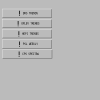SEI - All good.
SUS - All good.
ISC - Sheila and Nutsinee were moving PR3 last night to increase optical gain. Pop beam diverters are still open due to REFL WFS trouble.
CDS - HW - Running, anemometers are all up except at EY. Heading to the vault today.
- SW - Stable. Working on installing Debian8 on various work stations. Seems sucessful so far. Impressed enough that they may want to replace everything with it, please be giving them feedback.
PSL - Still running. TCS as well.
Vac - Today Chandra would like ot tune the filaments on the RGAs, can be done from the CR. Looking for partial pressure changes in locklosses.
Fac - If you find something broken, please just call the appropriate person rather than emailing because they may not get to the email in a timely manner.
Cal - Got the last set of measurements last night, about ready to update the calibration.
Reviewed Fault reports
Robert and Annamaria will be coming to do PEM injections next week.
if you see cds macbooks 3 & 7, please bring them back to Carlos or Jim B.
















